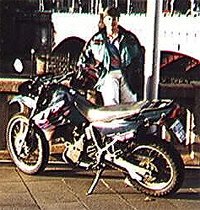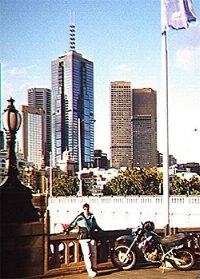![[Dirt Bikes]](../../../images/Navigation/Buttons/DirtBikes.gif)

|
Date: February 7, 1998
Location: Melbourne, Australia
Rider: Brad (Pinhead) Allen
It was my last weekend of this trip to Melbourne,
Australia, and I was determined to make this a memorable one. I decided to rent a
motorcycle and head out to what the Australians would call "the Bush." I wanted
to see a kangaroo in the bush, not in a pen. This was likely my last chance.
Only one shop in Melbourne rents bikes. Over the phone, I opted for the ZX750 Kawasaki.
They indicated that I could have their '96 model. It was between that and the GSX750
Suzuki. Sounds like some wicked hardware? One small problem, an "R" is missing
from each of the model names, ZX750R and GSXR750.
 Upon arriving at the rental shop I asked
to see the ZX750. I laughed out loud at the salesmen when he showed me the Kawasaki Zephyr
he intended for me to rent. It had a downsized frame smaller than my wife’s '87
DR200R Suzuki, and a tear drop gas tank. With the large disparity between their idea of a
street bike and mine, I decided to examine on/off bikes. The best I could find was a
Kawasaki KLR650; it was a total ELEPHANTE style bike. I joked to the salesmen, how much
does this thing weigh? He guessed around 200 kg (440 lb.) Upon arriving at the rental shop I asked
to see the ZX750. I laughed out loud at the salesmen when he showed me the Kawasaki Zephyr
he intended for me to rent. It had a downsized frame smaller than my wife’s '87
DR200R Suzuki, and a tear drop gas tank. With the large disparity between their idea of a
street bike and mine, I decided to examine on/off bikes. The best I could find was a
Kawasaki KLR650; it was a total ELEPHANTE style bike. I joked to the salesmen, how much
does this thing weigh? He guessed around 200 kg (440 lb.)
With my new rental, I figured a trip into the dirt was now mandatory. Forecasts for the
weather indicated rain that day. I had no moto armour, no boots, no shin guards. I had
only jeans, a full face helmet, the jacket part of a rain-suit, tennis shoes, and a back
pack loaded with 20 lbs of stuff so I could sleep in the bush if necessary.
 I headed for the Great Ocean
Road and reached Apollo Bay at around 2:00 PM when it began to rain. I pressed on looking
for the deepest and best looking section of "the bush" to enter. I searched
using my map of Victoria, a state that is probably bigger than the northern half of
California. After going all the way to Port Campbell, around 350 Kilometers, I decided to
try dirt riding outside of Lavers Hill. I headed for the Great Ocean
Road and reached Apollo Bay at around 2:00 PM when it began to rain. I pressed on looking
for the deepest and best looking section of "the bush" to enter. I searched
using my map of Victoria, a state that is probably bigger than the northern half of
California. After going all the way to Port Campbell, around 350 Kilometers, I decided to
try dirt riding outside of Lavers Hill.
I stopped at the only real gas and café in Lavers Hill, and asked for suggestions on
routing. Pointing to a dotted road on the map, I asked how’s this one. The store
owner replied "don’t go down there! I won’t even take my 4WD down there
anymore!" As we talked more he kept suggesting alternate routes in an attempt divert
me from my scheduled plan. I ate my meat pies and coffee and was off on my
originally-planned route, of course.
The start of it began with a descent down the road to Cobden. I locked and slid the front
wheel only once through the first stretch. Next I came to a crossing with another trail,
sand pit road. The sand was loose and the front end of the ELEPHANTE began hunting badly.
No worries, I thought, shifting my weight further aft. None
of the road signs matched anything on my map any longer. I had gone 450 km, most of it one
way. It would be dark in an hour, it was raining harder than ever, and I was off my map,
making turns on the basis of general direction alone. I turned on a track labeled Mount
McKinley track. A sign clearly stated "for dry conditions only." This was the
dry season I rationalized to myself, no worries.
After a few kilometers the track broke into steeper grades, and
the soil turned to slick and snotty silt. The ELEPHANTE might as well have had slicks
because its tires immediately filled. The next hill was steep, and third gear was my only
hope. I tried to temper the throttle but the rear end of the ELEPHANTE came around so fast
that the front end broke loose and dropped behind it. The ELEPHANTE was down, and I was
trapped under it, the muffler on my leg, and the throttle WFO. I fought the ELEPHANTE for
the relief from the muffler, and for the higher ground, with saving the motor only a
tertiary priority. We spun in circles somehow damaging both sides of the bike, and my
legs. It was a gooey mess.
Once free from the ELEPHANTE, I struggled 4 times to bring it up on two wheels, each time
slipping flat in the mud. Gas was flowing in from the tank in a continuous stream. I spun
the ELEPHANTE so the tires were downhill and I lifted with everything I had. The front
brake offered no resistance, the transmission would not shift, both mirrors and the
throttle controls were twisted, and they didn’t give me a tool kit. The brake
restored after lots of pumping and smacking the master cylinder. With brakes restored, I
back tracked down the hill stopping later to remove the mangled mirror, bend back the
gearshift and fix the others.
Within a few turns I found at sign indicating the town of Colac was only 49 km away and
graciously accepted.
Once on a two lane road to Colac I tapped the ELEPHANTE for 130
km/hour and held it all the way to Geelong. The return from here was relatively uneventful
although hydroplaning the ELEPHANTE really sucked. The road was worn and the tire pails
were puddled. I nearly got blown off the road by two 18-wheelers that must have been
experimenting with the same phenomenon from the oncoming direction.
I never saw a Kangaroo in the wild, although this my have been more lucky than bad. If I
had seen one, particularly on the way home, I’d probably have gotten a mouthful of it
at 130 km/hour.
Lesson learned: ELEPHANTEs are hard, hot, and heavy. I am soft, warm, and squishy, and
must remain warm, not too hot, not too cold, in order to survive.

Pinhead
|
